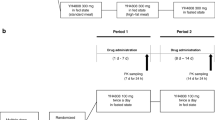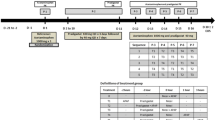Abstract
Purpose. The aim of this research was to determine the mechanism by which a co-administered meal decreases the oral absorption of bidisomide and does not influence the oral absorption of the chemically-related antiarrhythmic agent, disopyramide.
Methods. Bidisomide plasma levels, following oral administration and intravenous infusion in the fasted state and with various meal treatments, were determined in human subjects. A dialysis technique was employed to examine the potential for drug binding to meal homogenates. Plasma levels, following drug administration through duodenal and jejunal intestinal access ports and following various meal treatments with oral drug co-administration, were compared for bidisomide and disopyramide in a canine model.
Results. Bidisomide plasma AUC was significantly reduced following oral drug co-administration with breakfast compared to fasted-state controls in human subjects and in dogs independent of the composition of the solid cooked breakfast. While intravenous bidisomide infusion in human subjects showed a statistically significant reduction in AUC 15 minutes after oral administration of a high fat breakfast as compared to drug infusion in the fasted state, the reduction (−13%) was substantially smaller than the reduction (from −43% to −63%) observed with oral bidisomide meal co-administration. The percentages of bidisomide and disopyramide lost by binding to homogenates of cooked breakfast were 25.0 ± 5.7% and 23.7 ± 7.7%, respectively, as determined by dialysis at 4 hours. In dogs, the extent of absorption of disopyramide was comparable from oral, duodenal and mid-jejunal administration while the extent of bidisomide absorption from mid-jejunal administration was significantly lower than for oral or duodenal administration. Non-viscous liquid meals decreased Cmax but not AUC, while viscous homogenized solid meals decreased both Cmax and AUC for bidisomide with oral drug-meal co-administration. Oral non-caloric hydroxypropyl methylcellulose meals decreased bidisomide to the same extent as homogenized solid meals but did not lower disopyramide AUC.
Conclusions. The significant reduction in bidisomide plasma levels observed with meal co-administration in human subjects was predominantly mediated through a reduction in drug absorption and was independent of solid meal composition. The difference in meal effect on the absorption of the two drugs in humans did not appear to be a function of drug binding to cooked meal components over typical human upper gastrointestinal residence times. In dogs, the high-viscosity medium generated by oral co-administration of a solid meal reduced the upper intestinal absorption of bidisomide and disopyramide. Bidisomide AUC was decreased since it was well absorbed in the upper but not lower small intestine. Disopyramide AUC was not significantly affected since it was well absorbed from both regions. A similar mechanism may play a role in drug plasma level reductions following oral co-administration with solid meals for drugs showing similar regionally-dependent absorption profiles.
Similar content being viewed by others
REFERENCES
A. Karim, J. Clin. Pharmacol. 35:921 (1995).
A. Karim, A. Piergies, and P. Needleman, J. Clin. Pharmacol. 35:921 (1995).
C. S. Cook, S. J. McDonald, and A. Karim. Xenobiotica 23:1299–1309 (1993).
C. S. Cook, G. B. Ames, M. E. Smith, K. G. Kowalski, and A. Karim. Pharm. Res. 10:1675–1682 (1993).
C. S. Cook, G. B. Ames, J. D. Hribar, N. W. K. Liu, D. L. Sweeney, G. L. Schoenhard, and A. Karim. Xenobiotica 25:981–991 (1993).
C. S. Cook, L. Zhang, G. X. Xu, and G. L. Schoenhard. Pharm. Res. 14:1032–1040 (1997).
S. Garthwaite, F. Hatley, L. Frederick, J. Ruby, and C. S. Cook. Drug Develop. Res. 17:119–133 (1989).
M. G. Sarr and K. A. Kelly. Am. J. Physiol. 239:G497–G503 (1980).
Methocel Cellulose Ethers (Technical Handbook). Midland, MI. Dow Chemical, p. 13.
L.D. Meunier, J. T. Kissinger, J. Marcello, A. J. Nichols, and P. L. Smith. Lab. Anim. Med. 43:466–470 (1993).
G. Y. Kwei, J. R. Gehret, L. B. Novak, M. D. Drag, and T. Goodwin. Lab. Anim. Med. 45:683–685 (1995).
E. A. Mayer. In Physiology of gastrointestinal tract, 3rd., New York: Raven Press. pp. 929–976 (1994).
C. M. Stevenson, L. L. Radulovic, H. N. Bockbrader, and D. Fleisher. J. Pharm. Sci. 86:953–957 (1997).
C. Miles, P. Dickson, K. Rana, C. Lippert, and D. Fleisher. Regul. Pep. 68:9–14 (1997).
D. Fleisher, C. L. Lippert, N. Sheth, C. Reppas, and J. Wlodyga, J. Cntrl. Rel. 11:41–49 (1990).
P. K. Gupta and J. R. Robinson. Int. J. Pharm. 43:45–52 (1988).
C. Reppas, J. H. Mayer, P. J. Sirois, and J. B. Dressman. Gastroenterology 100:1217–1223 (1991).
L. Lachman, H. A. Lieberman, and J. L. Kanig. The theory and practice of industrial pharmacy. 3rd ed. Philadelphia: Lea & Febiger. p. 131 (1986).
E. L. Cussler. Diffusion, mass transfer in fluid system. New York: Cambridge University, pp. 118–122 (1986).
D. E. Greenwood's dissertation at The University of Michigan, pp. 18–69 (1994).
L. Z. Benet, C. Y. Wu, M. F. Hebert, and V. J. Wacher. J. Cntrl. Rel. 39:139–143 (1996).
D. Borckmeier, H-G. Grigoleit, and H. Leonhardt. Eur. J. Clin. Pharmacol. 29:193–197 (1985).
W. N. Charman, C. J. H. Porter, S. Mithani, and J. B. Dressman. J. Pharm. Sci. 86:269–282 (1997).
G. Y. Kwei, L. B. Novak, L. A. Hettrick, E. R. Reiss, D. Ostovic, A. E. Loper, C. Y. Lui, R. J. Higgins, I-Wu Chen, and J. H. Lin. Pharm. Res. 12:884–888 (1995).
J. A. Stone, W. D. Ju, A. Steritt, E. J. Woolf, K. C. Yeh, P. Deutsch, S. Waldman, and T. D. Bjornson. Pharm. Res. 13:S-414 (1996).
Author information
Authors and Affiliations
Rights and permissions
About this article
Cite this article
Pao, LH., Zhou, S.Y., Cook, C. et al. Reduced Systemic Availability of an Antiarrhythmic Drug, Bidisomide, with Meal Co-administration: Relationship with Region-Dependent Intestinal Absorption. Pharm Res 15, 221–227 (1998). https://doi.org/10.1023/A:1011958400362
Issue Date:
DOI: https://doi.org/10.1023/A:1011958400362




